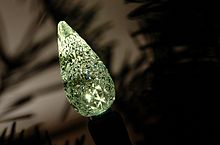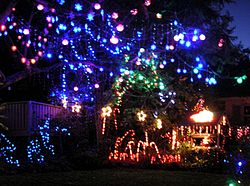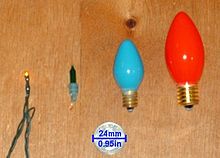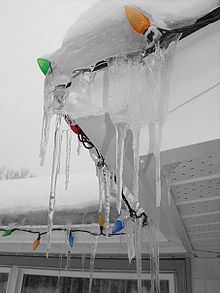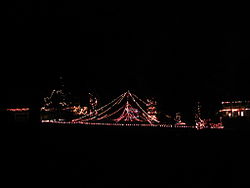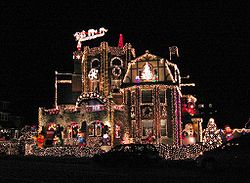- Christmas lighting technology
-
Christmas lighting technology has been subject to considerable development and variation since the replacement of candles by electric lights.
Contents
Incandescent Christmas Lights
Incandescent light bulbs have been commonly used in Christmas lights until recently. These lights produce a broad-spectrum white light, and are colored by coating the glass envelope with a transparent or translucent paint which acts as a color filter. Some early Japanese-made lamps, however, used colored glass.[1] While incandescent light sets are less expensive to purchase than similar LED sets, the operating cost is significantly more. The paint on the incandescent bulbs suffer from fading or flaking when exposed to weather. Older bulbs were also coated on the insides of the bulbs to prevent this effect, but were more costly to manufacture.
LEDs
Light-emitting diode (LED) Christmas lights are quickly gaining popularity in many places due to their low energy usage (about one tenth the energy used by incandescent bulbs), very long lifetimes, and associated low maintenance. Colored LEDs are also far more efficient at producing light than their colored incandescent counterparts.
There are two types of LEDs: colored LEDs and white LEDs. Colored LEDs emit a specific color light (monochromatic light), regardless of the color of the transparent plastic lens that encases the LED's chip. The plastic may be colored for cosmetic reasons, but does not substantially affect the color of the light emitted. Christmas lights of this type do not suffer from color fading because the light is determined by the LED's chip rather than the plastic lens. In addition, the plastic lens is much more durable than the glass envelope of incandescent bulbs.
White LEDs are similar to colored LEDs in most respects such as power and durability, but utilize a two-stage process to create the white (polychromatic, or broad spectrum) light. In the first stage, the LED actually only produces one color of light, similar to any other LED. In the second stage, some of the blue or violet-blue is absorbed by a phosphor which fluoresces yellow, imitating the broad spectrum of colors which our eyes perceive as "white". This is essentially the same process used in fluorescent lamps except for the use of an LED to create blue light rather than excited gas plasma to create ultraviolet.
White LEDs can be used as white Christmas lights or to create any other color through the use of colored refractors and lenses similar to those used with incandescent bulbs. Color fading may occur due to the exposure of colored plastics to sunlight or heat, as with ordinary Christmas lights. Yellowing may also occur in the epoxy "bulb" in which the LED is encased if left in the sun consistently.
LEDs use much less electricity (only 4 watts for a 70-light string) and have a much greater lifespan than incandescent lamps. Since they are constructed from solid state materials and have no metallic filaments to burn out or break, LEDs are also much less susceptible to breakage from impact or rough handling.
Although LEDs themselves are long-life devices, older or lower-quality strands of LED-based Christmas lights can suffer from early failure. This is particularly so with blue ones, which are the newest and most expensive, and therefore prone to cost-cutting; in addition, spares are rarely included with sets. Most LED-based Christmas lights use copper wire which connects to the aluminum-based wires of the LEDs. Exposing this combination of metals to moisture can result in galvanic corrosion inside of the lamps' sockets, causing them to stop working. Many other sets use cheaper steel leads on the LEDs, which instead rust, leading to the same result. Some older sets of LED Christmas lights have each LED permanently mounted in a non-removable weathertight base to keep out rain and other moisture, helping to prevent such corrosion; however, this prevents the user from replacing defective bulbs.
Most common consumer LED lamps produce intense, deep, pure colours, versus incandescent bulbs which generally have subtler, yellow-tinted colours, often somewhat faded especially if used outside. Blue tends to be the dimmest incandescent color, but the brightest in LED. While yellow is just the opposite. Very early strings of LED lights were noticeably dimmer than incandescent bulbs but now are often noticeably brighter. These factors combine to give LED lamps a distinct aesthetic from older incandescent strings, although white LEDs behind coloured lenses do offer the ability to provide a more incandescent-type appearance with most of the benefits of energy efficiency. In contrast, coloured-chip type LEDs produce intense colours. The negative aesthetics are largely due to the maturity of coloured LED versus newer white LED technology. As the technology improves so will the ability to change the aesthetics of the lamps at lower cost than at present. In 2007, "warm white" LED sets (having a color similar to that of a compact fluorescent light) became commonly available for the first time in U.S. stores. This color however would need to have more of an orange tint to match the color of very small incandescent bulbs because they burn at a lower temperature. Still, this provides a much closer match to incandescent light color than was available when only very cool (bluish) white was available. One can choose cool-white LEDs for their crisp or snow-white quality or warm white LEDs for their more familiar incandescent-like color.
Additionally, low-end sets do not contain power supplies (or have only a transformer instead of a SELV), and so the bulbs flicker in sync with the alternating current, being completely off when the voltage is negative. This produces a noticeable stroboscopic effect when an individual happens to move the lights across his or her field of view quickly, as when moving the eyes or turning the head rapidly. Higher-quality strings include a bridge rectifier to supply full-wave direct current to the lamps, making the lights brighter and greatly reducing the flickering (though there is still a small amount because diodes need a minimum voltage to begin conducting). Cheaper sets with two circuits connect each in the opposite polarity, which minimizes flicker in the combined light reflected from walls and also keeps power consumption symmetrical so as not to affect the electrical system.
Many mini sets use standard 3 mm dome-shaped LEDs, and have a plastic cover over them to provide refraction, which is an important step in diffusing the unidirectional light they cast. These covers come in C5, C6, and C7 sizes (⅝, ¾, and ⅞-inch, or 16, 19, and 22 mm diameters, respectively) pointed "strawberries," G12 (12mm or almost ½-inch) globe "raspberries," and "M5" (5mm or 7⁄32-inch) pointed cylinders, equivalent to the T1¾ mini lights so common since the 1980s. For blue and green, these covers may have some fluorescence, leading to a lighter color. Other sets have 5 mm domes with no covers because these project light in one direction. Instead they have a cone-shaped indentation on the top to refract light out to the sides. Still other sets have covers like snowflakes (or for Halloween, pumpkins). There are also multi-LED screw-in bulbs which replace real C7½ and C9¼ bulbs and are much closer in brightness than the mini imitations.
One drawback discovered to this technology for outdoor lighting, at least in North America, has been that squirrels have been found damaging them. The species must wear down their continually growing incisors by gnawing on hard objects. They apparently find the diode's durable plastic construction useful for this need, while its low power consumption means a minimal chance of electrical shocks to discourage them. Animal experts have suggested leaving edible hard nuts on the ground around lighting fixtures to distract the rodents with food that can also serve the same dental needs.[2]
Fiber optic lights
Fiber optic technology is also used in Christmas lighting, especially by incorporating it into artificial Christmas trees. Incandescent lamps or LEDs are located in the tree base and many optic fibers extend from the lamps to the ends of the tree branches. These devices frequently use a step-down transformer because they have only one or two lamps or LEDs.
Bubble Lights
Bubble lights are a type of incandescent novelty light that acquired some popularity during the 1950s. Their main feature is a sealed glass tube with a colored bubbling liquid inside, created by the heat from the incandescent light. The fluid within the vial was originally a lightweight oil but now is methylene chloride for a more consistent bubble effect. While the idea was first demonstrated by Benjamin Franklin, the idea was adapted for use in Christmas Lights. They were invented by Carl Otis in 1935 who sold the patents to the NOMA Electric Corporation. There is a long story involving patent fights.[3] Bubble Lights can still be purchased online and in stores to this day.
Light sculptures
Lights are sometimes mounted on frames—typically metal for large lights and plastic for miniature ones. These were first used for public displays on lampposts, street lights, and telephone poles in cities and towns. For public displays large C7 bulbs are generally used, but by the 1990s light sculptures were being made in smaller form with miniature lights for home use. Consumer types now tend to come with a plastic sheet backing printed in the proper design, and in the 2000s now with nearly photographic quality graphics and usually on a holographic "laser" backing. Public displays often have outdoor-rated garland on the frame as well, making them very decorative even in the daytime. Places where notable displays of light sculptures may be seen include Gatlinburg and Pigeon Forge in Tennessee.
On a smaller scale, one of the most popular light sculptures is the sparkleball. Sparkleballs are handmade globes made from threading Christmas lights into a sphere built of plastic cups. The cups are joined by soldering, cable ties, or with a hand stapler. Usually spotted individually on front porches at Christmas, the residents of North Yale Avenue, Fullerton CA have made a holiday tradition of hanging 450 sparkleballs from the trees lining their street.
Ornamentation
Early bulbs were sometimes made in shapes and painted, the same way that glass ornaments are. These are typically pressed glass, much as common dishware was at the time. These are reproduced in very limited quantity nowadays, typically found only at specialty retailers and online. Metal reflectors were also used until the 1970s, having a center hub of paperboard, which then had tabs that pressed between the bulb and the socket.
Miniature lights sets can come with attached ornaments, typically plastic but sometimes glass. These began mid-century with petal "reflectors" which actually refracted the light and focused it in beams, and perhaps even earlier with crystal-like ones. On both types, the bulb stuck out of the center, and the "reflector" could be removed from the socket. Later designs, though much less popular, included stars. LED lights now come molded into shapes, though the light comes from the top instead of the center.
Mini lights can also have full-size ornaments normally sold on sets of ten. Certain sets have more than one bulb per ornament, such as for snowmen and candy canes which are long. There is an enormous array of other designs, ranging from holly berries and poinsettias to star-shaped santas and wire mesh snowflakes. There are also ones for other holidays.
Sizes
- Note that the following may be particular to North America, and may vary in countries with mains other than 120 volts.
Christmas lighting began with small C6 bulbs — where the C means "cone" for the candle flame shape and the 6 indicates the diameter measured in eighths of an inch, ¾ inches (19 mm). These were on a miniature candelabra screw-base, now designated E10 (Edison screw, 10 mm). Replicas of these bulbs are now produced as miniature strings, usually with the entire bulb replaced, but sometimes with a decorative cover with regular bulbs inside. These bulbs tend to be transparent white or colors, and are often ornately designed with crystal-like patterns.
Later bulbs called C7½, have diameters of seven and a half 1/8th inches (15⁄16 in, or 24 mm)using an E12 candelabra base; however, these have a blunt shape (and should therefore be called B7½, or B24). Mixing metric and English units, there are also now G30 globes which are 30 mm (1 3⁄16 in, or G9½) in diameter using these sockets. These are still used for the classic or even retro look, and use about five watts each. Older bulbs drew 7½ watts of power, and were reduced to save power. Early bulbs, as well as some new antique reproductions, are made in various shapes and then painted like Christmas ornaments. Bubble lights and twinkle bulbs also come in this size.
Outdoor-only bulbs are designated C9¼ (1 5⁄32 in, or 29 mm), and have a similar blunt shape as the C7½, but use an E17 "intermediate" base. Some modern versions of these strings are now listed for indoor and outdoor use. These bulbs are rated at about seven watts each, and are available in a globe shape, designated G40 (40 mm, or 1 9⁄16 in). Some of the blunt-shape bulbs now come painted with designs, or swirled in more than one color. It is now very difficult to find twinkle bulbs in this size.
Standard mini lights are T1¾, indicating that they are a tube shape 7⁄32 inches (5.5 mm) in diameter. Larger mini bulbs, which began appearing around 2004, are about twice this size, but are still very uncommon. Both types, along with most of the candle-shaped ones, are pinched-off at the tip rather than the base during manufacturing. Most contemporary miniature light bulbs have an internal shunt that is intended to activate when the bulb's filament burns out. The shunt closes the circuit across the bad filament, restoring continuity which allows the rest of the string to remain lit.[4] However, if one shunt fails to close properly, the whole string will fail to light. Other miniature types include globe-shaped "pearl" and smaller "button" lights, which are often painted in translucent or pearlescent colors. "Rice" lights are tiny, like a grain of rice, and can even have a subminiature base, if they are not already fixed permanently to the wires (on low-voltage sets). Rice lights are typically transparent, although colored variations do exist. They are intended to create tiny points of light, and are suitable for decorating miniature models, small wreaths, and other similar situations in which even "midget" T1¾ lights may be too large.
LED lights, which are encased in solid plastic rather than a hollow glass bulb, may be molded into any shape. Because the LED casts light in only one direction, the most common way LED lights are designed, even "plain" sets having some sort of crystal pattern to create refraction.
Many bargain brands have dome-shaped LEDs which focus the light so that it sharply visible when viewed head-on, but almost invisible from a perpendicular direction. This has both advantages and disadvantages depending on one's decorating needs.
If a small LED bulb size but wider viewing perspective is desired, wide-angle LEDs are available. Rather than being dome-shaped (convex), the envelope is concave (sunken in) to cause wider distribution of light.
All miniature bulbs (including some LED sets) have a wedge base, though their designs are inconsistent with one another, making it somewhat difficult for the average consumer to change bulbs. To replace a bulb, the plastic base of the bulb must usually be changed by straightening the two wires and pulling the glass part out. Most replacement bulbs do not even include the bases anymore, despite getting only ten in a package and being charged nearly half the price of a new string of 100. For this reason, many Americans treat mini Christmas lights as disposable. In addition, colored lights tend to fade with even brief exposure to weather. Many LED sets are permanently wired, with bases that look like conventional pull-out bulbs.
Light sets
Traditional C6 bulbs were typically 15 volts, and used in series strings of eight bulbs, or multiples of 8. The use of eight bulbs (120 volts for 8 lamps equals 15 volts per lamp) gives each lamp the rated voltage for proper brightness. Later sets used nine bulbs on a string to increase the life of the bulbs by reducing the voltage each lamp received (120 volts divided by 9 lamps = 13 volts per bulb) but not significantly reducing the light output of the bulbs.
Large C7½ and C9¼ bulbs typically come in sets of 25, though bubble lights come in sets of seven, and some non-holiday sets come in ten or twelve. Sockets are usually spaced about one foot or 30 cm apart, and are clamped to the wire with an integrated insulation-piercing connector. Some older parallel sets had 15 bulbs, as do some of the newer globe sets manufactured today. Both of these bulbs are designed to run on 120 volts and the light sets that use them are parallel wired.
Mini lights first came in sets of 35 (3.5 volts per bulb), and sometimes smaller sets of 20 (6 volts per bulb). For a short time, these early mini lights were manufactured using E5 screw bases rather than the current wedge base and were called "italian lights". Sets of ten (12 volts per bulbs) were made for very small trees, but are quite hot, and are now usually used for tree toppers only. This number is convenient for stars, which have a total of ten points (five outward and five inward), and often have another light in the middle, occasionally on both sides.
Incandescent miniatures now usually come in sets of 50 or 100 (which contains two circuits of 50) 2.5 V 170 mA bulbs, though decorative sets with larger bulbs (C6 or pearl style) typically come in sets of 35 or 70. Several "extra-bright" sets also use 70 or 105 bulbs, keeping the per-bulb voltage at 3.5 instead of 2.5.
LED sets can vary greatly. Common is a set of 60 (2 volts per bulb), but white LED sets use two circuits of 30 (4 volts per bulb). Multicolor sets may have special wiring, because red and yellow require less voltage than the newer blue-based ones (blue, emerald green and fluorescent white), but typically come in sets with a multiple of 35.
Battery-powered sets typically come in 10 or 12, and can use standard 2.5 to 3.5-volt bulbs because they run two batteries, totaling three volts or less. LEDs are becoming increasingly common as they greatly prolong battery life, but because they also last longer they are often soldered directly to the wires, making up for some of the increased cost of the newer LEDs. 'Rice lights" are often made this way as well, and likewise may also have more bulbs per set as they draw somewhat less power per bulb than other incandescents.
Control technology
Christmas lights can be animated using special "flasher" or "interrupter" bulbs (usually a red tipped replacement bulb included with the set) or by electronic controller. Flasher bulbs use a bi-metallic strip which interrupts the series circuit when the lamp becomes hot.[5] An electronic Christmas light controller usually has a diode bridge followed by a resistor-based voltage divider, a filter capacitor and a fixed-program microcontroller. The micro-controller has three or four outputs which are connected to transistors or thyristor which control interleaved circuits, each with lamps of a single color.
Controllers can be set up to change flashing or animation styles by pressing a button or turning a dial on the unit; others have only one pattern, but the speed of this pattern can usually be adjusted by turning a similar dial.
Most multi-function sets feature 8 to 16 moving light functions. Some very common functions are fading and chasing. More extravagant and less common functions are stepping on and 2-channel flashing. These lights usually come in sets of 140 or 150. This is because to give the chasing effect, bulbs must be arranged in 4 circuits of 35 (equals 140) or 3 circuits of 50 (equals 150). These light sets use even less power than a regular set of 150 because the lights are not always on, and therefore the bulbs do not get as hot.
Usually, computerized sets cannot be connected end-to-end. However, some newer sets contain special miniature plugs - a female jack is located at the end of the set, and a male plug is located between the control box and the beginning of the actual lights. By disconnecting the control box from one set, it can now be plugged into the end of an identical chasing set to produce a longer strand of chasing lights. These plugs generally have a twist-on locking feature similar to that found on garden hoses.
Computer Controlled Christmas displays are becoming more and more common today. For instance a display in Texas, Christmas In Jasper, uses a PIC-based dimmer scheme, and also refers to dimming controllers that people have built based on this scheme. The designs all use mid-range PIC micro-controllers, are generally modular in units of eight channels (dimmable circuits), and use medium-speed, daisy-chainable, one-direction serial communications for input. Most controllers do not have stand-alone show sequencing capabilities, and rely on a separate computer (usually a PC) to send it real-time sequences of dimmer commands. This setup is strictly a do-it-yourself project, and there aren't any commercial (hardware or software) products available. There are, however, a number of PCB designs that people have created.[6]
Fiber-optic Christmas lighting can also be animated electronically, particularly when the set incorporates LEDs. When an incandescent lamp is used, animation can created by means of a rotating color wheel.
There's a new control technology being developed in Ottawa, Canada Lights On Calico which enables multiple homes to link up over the Internet in-real time and in-synch. A central website initiates the timing using Network Time Protocol to keep the local computers in synch, and each location has a small Java program that controls a device which interfaces with the USB port to which your Christmas lights plug into. In this way, anyone online can "plug in" to this network and at their discretion working independently or in-synch engage their Christmas Light display on a global level.
Power considerations
Incandescent (midget) or LED-based sets usually have each lamp connected in series to be powered without a transformer in the set. Screw-base C7 and C9 light sets use line voltage (120 volt) bulbs and are wired in parallel. LED-based sets use a current-limiting resistor to reduce the current supplied to each LED. Neon-lamp-based sets have lamps connected in parallel, each with its own current-limiting resistor. Battery-powered sets are also wired in parallel.
Some incandescent or LED-based strings use a power supply transformer with lamps connected in parallel. These sets are much safer, but there is a voltage drop at the end of the string causing reduced brightness of the lamps at the end of the set. The reduced brightness is, however, less noticeable with LED-based sets than incandescent sets. Power supplies with integrated plugs may make the set difficult to connect in certain places.
A line-operated AC string with a male plug on one end and a female socket on the other end can be conveniently connected end-to-end with other similar strings. The gauge of wire used, current rating of the fuse (if present) and the power consumption of each string will determine how many strings can be safely daisy-chained this way, or whether the end string will have diminished voltage and brightness.
Troubleshooting
Individual bulbs fail either open or shorted. In a series string, when a bulb fails open, the whole string goes out, unless there is a special feature included to bridge the open bulb. An alternative repair device is known as the LightKeeper Pro.[7] Typical incandescent strings in the 1950s - 1960s were wired in series and frequently burnt out.
For a series string, fixing failures requires a tedious process: each bulb is replaced with a known good bulb, hunting for the broken one by trial-and-error. If more than one bulb is broken, then each bulb in the broken string needs to be tested in a known-good string. Sometimes a bulb will not actually break, but will come loose in its socket. Its connection can also become corroded. Those two problems can be fixed by resetting each bulb in turn.
In a parallel string, one shorted bulb makes the whole string fail, requiring a similar troubleshooting process. However, the shorted string must be protected by a current limiting device, which may require resetting in between tests.
Fiber optic sets are the simplest to troubleshoot, since they contain only a few light sources, sometimes only one or two, and the place of failure can be located very quickly. Units containing color wheels may also require maintenance of mechanical parts.
Safety
Any set should be unplugged before repairing. If a set has no transformer, it is not line isolated. The small matchbox-sized electronic controllers do not have transformers in them, and sets with such controllers are also not line isolated, as well as all parts inside the controllers.
The number of strands of continuous light sets that may be safely daisy-chained in sequence varies based on whether the lights are LEDs, ordinary miniature light bulbs, or the larger C7/C9 type light bulbs. Other factors include the voltage of the set and the size of the wiring in the set. Those with questions should consult the manufacturer's instructions or an electrician.
Most light sets come with built in fuses to help protect against overheating and to prevent household fuses or circuit breakers from being tripped. If a fuse blows, the strand must be unplugged and the number of strands must be reduced. If the strand has nothing attached, or has blown repeatedly, it may contain a short circuit and should be repaired or discarded.
Hobbyists who don't want to pollute the environment by discarding a damaged set can cut it into many individual bulbs, each of which can be powered by a safe low voltage source. These bulbs can be used in projects such as microcontroller or PC controlled animated displays. The AC power plugs are usually crimped and molded on, however, and cannot be safely re-used.
Some fiber optic sets may use halogen bulbs in their bases, in such cases, all precautions related to this type of bulbs should be observed.
Animated sets should not be watched by people having photosensitive epilepsy. Non-animated sets exist and can be used in such cases.
An episode of the show MythBusters covered the possible fire danger from Christmas lights
As with most electrical devices bare wires are a sign the string should be discarded, and avoid overloading individual cords.
References
- ^ Nelson, George. "The Evolution of the Series-Type Christmas Light Bulb". The Antique Christmas Lights Museum. Archived from the original on 2006-10-20. http://web.archive.org/web/20061020231535/http://www.oldchristmaslights.com/lamp_evolution.htm. Retrieved 2006-11-12.
- ^ "Squirrels go nuts for tasty Christmas lights". CBC News. 2008-12-04. http://www.cbc.ca/canada/manitoba/story/2008/12/04/pesky-varmints.html?ref=rss.
- ^ Nelson, George. "The History of Bubble Lights". The Antique Christmas Lights Museum. Archived from the original on 2006-11-24. http://web.archive.org/web/20061124211929/http://www.oldchristmaslights.com/bubble_lights1.htm. Retrieved 2006-11-28.
- ^ Minilights - shunts
- ^ "How Christmas Lights Work". How Stuff Works. http://christmas.howstuffworks.com/christmas-lights3.htm. Retrieved 2006-11-12.
- ^ Ternary computers as a "Christmas lights" controllers
- ^ http://en.wikipedia.org/wiki/LightKeeper_Pro
External links
Categories:- Christmas traditions
- Lighting
Wikimedia Foundation. 2010.

